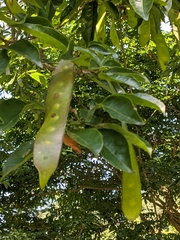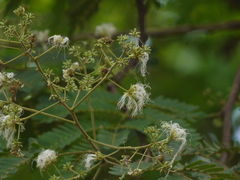Albizia odoratissima: taxon details and analytics
- Domain
- Kingdom
- Plantae
- Phylum
- Tracheophyta
- Class
- Magnoliopsida
- Order
- Fabales
- Family
- Fabaceae
- Genus
- Albizia
- Species
- Albizia odoratissima
- Scientific Name
- Albizia odoratissima
Summary description from Wikipedia:
Albizia odoratissima in languages:
- Thai
- กางขี้มอด
Images from inaturalist.org observations:
We recommend you sign up for this excellent, free service.
Parent Taxon
Sibling Taxa
- Albizia acle
- Albizia adianthifolia
- Albizia adinocephala
- Albizia altissima
- Albizia amara
- Albizia androyensis
- Albizia anthelmintica
- Albizia antunesiana
- Albizia arenicola
- Albizia atakataka
- Albizia attopeuensis
- Albizia aurisparsa
- Albizia aylmeri
- Albizia balabaka
- Albizia bernieri
- Albizia boinensis
- Albizia boivinii
- Albizia brevifolia
- Albizia buntingii
- Albizia burkartiana
- Albizia burmanica
- Albizia calcarea
- Albizia canescens
- Albizia carrii
- Albizia chevalieri
- Albizia chinensis
- Albizia commiphoroides
- Albizia coriaria
- Albizia coripatensis
- Albizia corniculata
- Albizia crassiramea
- Albizia decandra
- Albizia divaricata
- Albizia dolichadena
- Albizia duclouxii
- Albizia edwallii
- Albizia elegans
- Albizia euryphylla
- Albizia ferruginea
- Albizia forbesii
- Albizia glaberrima
- Albizia glabripetala
- Albizia grandibracteata
- Albizia greveana
- Albizia guillainii
- Albizia gummifera
- Albizia harveyi
- Albizia inundata
- Albizia jaubertiana
- Albizia julibrissin
- Albizia kalkora
- Albizia kostermansii
- Albizia lankaensis
- Albizia lathamii
- Albizia laurentii
- Albizia lebbeck
- Albizia lebbekoides
- Albizia leonardii
- Albizia leucocalyx
- Albizia lucidior
- Albizia mahalao
- Albizia mainaea
- Albizia malacophylla
- Albizia masikororum
- Albizia morombensis
- Albizia mossamedensis
- Albizia multiflora
- Albizia myriophylla
- Albizia niopoides
- Albizia numidarum
- Albizia obbiadensis
- Albizia occidentalis
- Albizia odorata
- Albizia odoratissima
- Albizia ortegae
- Albizia papuensis
- Albizia pedicellaris
- Albizia pedicellata
- Albizia perrieri
- Albizia petersiana
- Albizia philippinensis
- Albizia pistaciifolia
- Albizia poilanei
- Albizia polycephala
- Albizia polyphylla
- Albizia procera
- Albizia purpusii
- Albizia retusa
- Albizia rhombifolia
- Albizia rosulata
- Albizia rufa
- Albizia sahafariensis
- Albizia salomonensis
- Albizia saponaria
- Albizia schimperiana
- Albizia sinaloensis
- Albizia splendens
- Albizia subdimidiata
- Albizia suluensis
- Albizia tanganyicensis
- Albizia thompsonii
- Albizia tomentella
- Albizia tomentosa
- Albizia tulearensis
- Albizia umbrosa
- Albizia vaughanii
- Albizia verrucosa
- Albizia versicolor
- Albizia viridis
- Albizia westerhuisii
- Albizia xerophytica
- Albizia zimmermannii
- Albizia zygia





















































